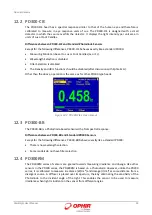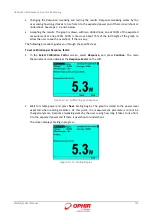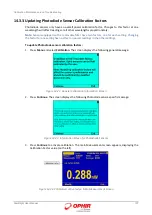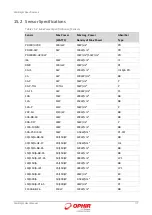
Calibration, Maintenance, and Troubleshooting
StarBright User Manual
106
14.3
Calibration of Photodiode Sensors
Photodiode detectors are inherently very linear but also have a large variation in sensitivity with
wavelength. In addition, most sensors from the Ophir model PD300 series are equipped with both
a built in filter and removable filter to allow measurement of higher powers without detector
saturation. These filters also have a transmission that depends on wavelength. Therefore, when
the PD300 is being used with StarBright, the StarBright has a built in calibration adjustment for
wavelength which is described in the next paragraph.
14.3.1
Method of Factory Calibration
The sensitivity of various Ophir Photodiode sensors can vary from one to another as well as with
wavelengths. Therefore, Ophir Photodiode detectors are individually calibrated against NIST
traceable standards over the entire operating range of wavelengths for both filter out and filter in.
The calibration curve is normalized to the correct absolute calibration at 632.8 nm using a HeNe
laser against a reference meter traceable to NIST.
The spectral sensitivity curve of the detector as well as the spectral transmission curve of the
filters is fed into the sensor EEROM and this information is used to set the gain to the proper value
at wavelengths other than the wavelength the instrument was calibrated. When the user selects
his wavelength on the StarBright, the correction factor for that wavelength is applied.
14.3.2
Accuracy of Calibration
Since the instruments are calibrated against NIST standards, the accuracy is generally ±2% at the
wavelength the calibration has been performed. The maximum error in measurement will be less
than the sum of the calibration accuracy, linearity, inaccuracy due to errors in the wavelength
curve and variations in gain with temperature. The linearity of the Photodiode detector is
extremely high and errors due to this factor can be ignored. The maximum error due to the above
factors is listed in
Table
14-1 Maximum Error as a Function of Wavelength and Filter
Wave Length
Error, Filter Out*
PD300 PD300-TP PD300-3W PD300-UV PD300-IR PD300 -IRG 3A-IS
200 - 270nm
±6%
270 - 360nm
-
-
±3%
-
360 - 400nm
±10%
±7%
±10%
±3%
-
400 - 950nm
±3%
±3%
±3%
±3%
5%
950 - 1100nm
±5%
±5%
±5%
±5%
±4%
10%
1100 - 1650nm
-
-
-
±4%
±3%
1650 - 1800nm
-
-
-
±7%
±5%
* Add ±2% to error for filter in (±4% for PD300-UV from 220 to 400nm).
Note:
More exact specifications will be found in the latest
















































